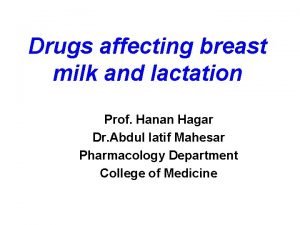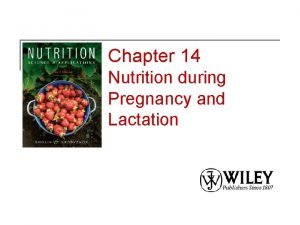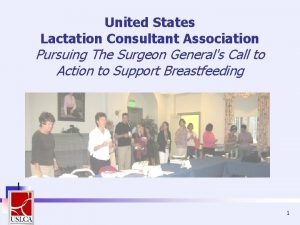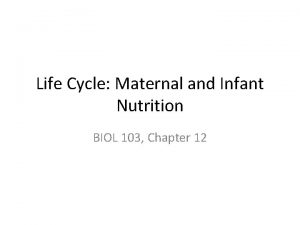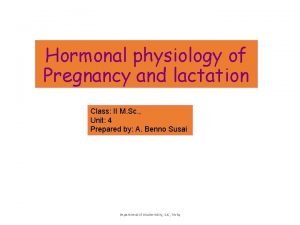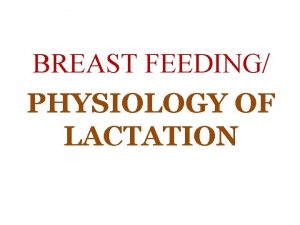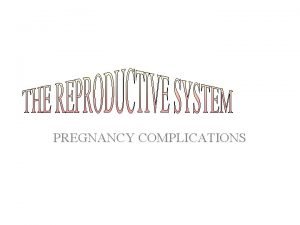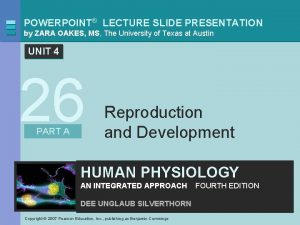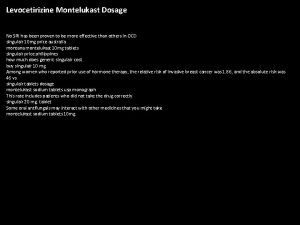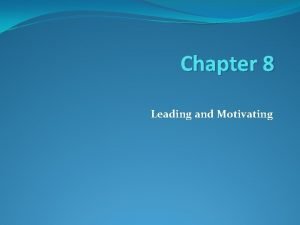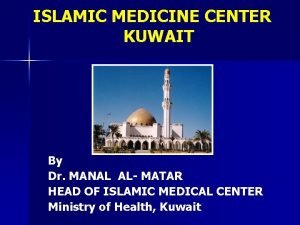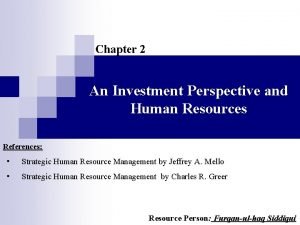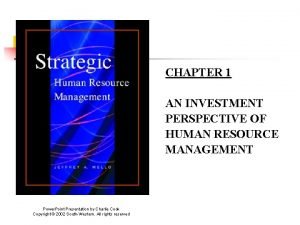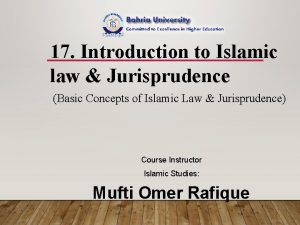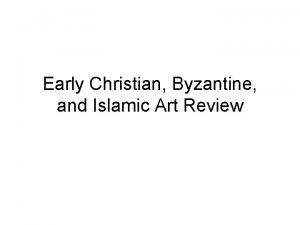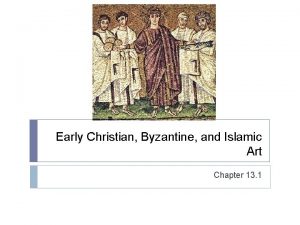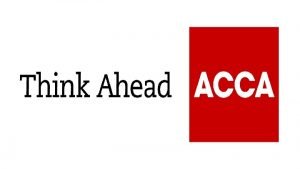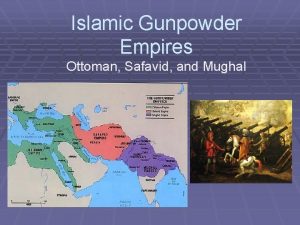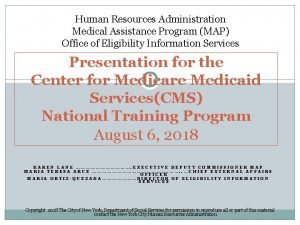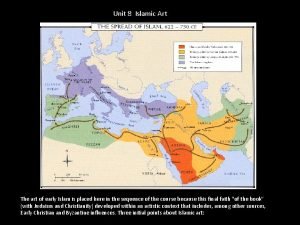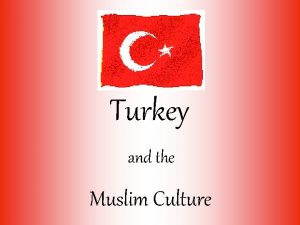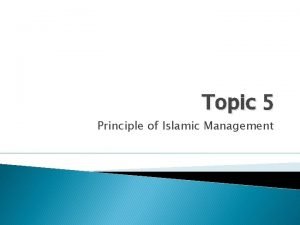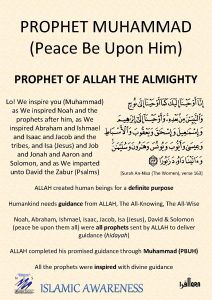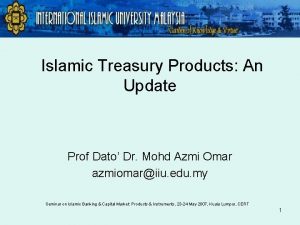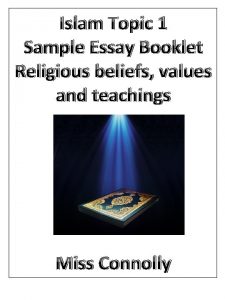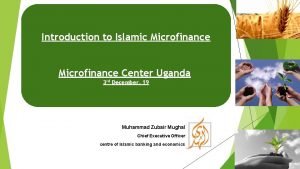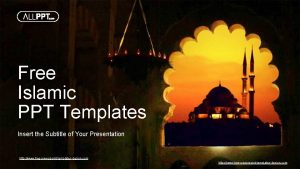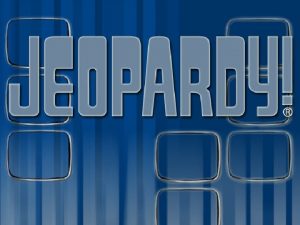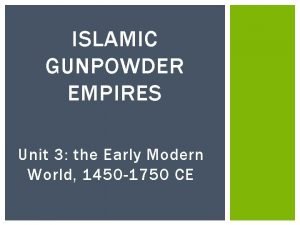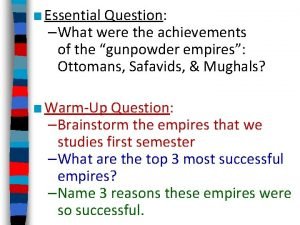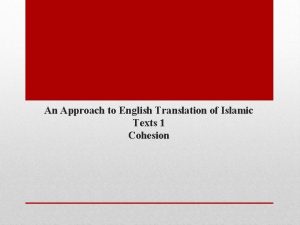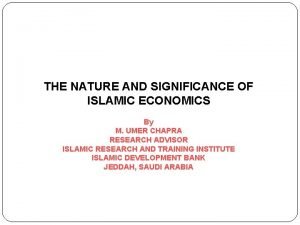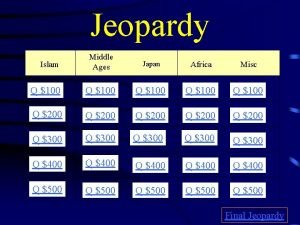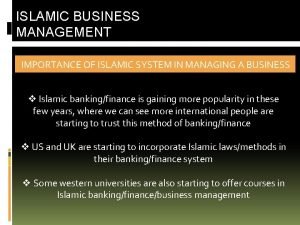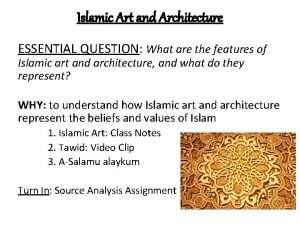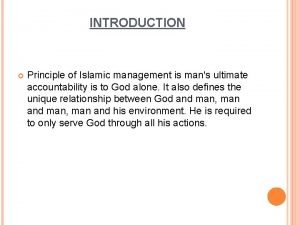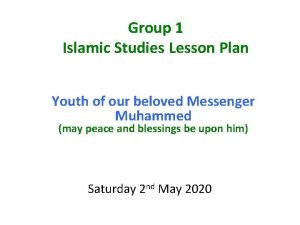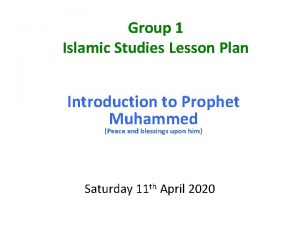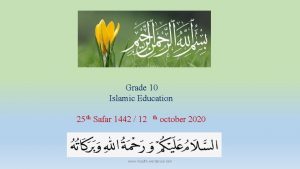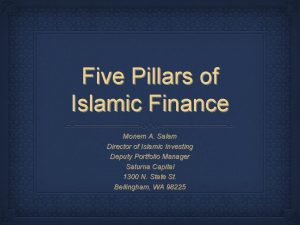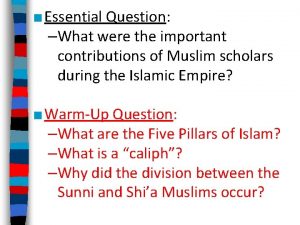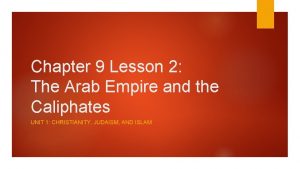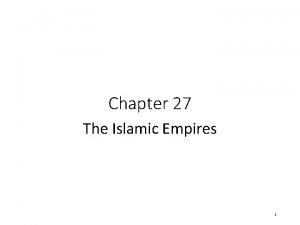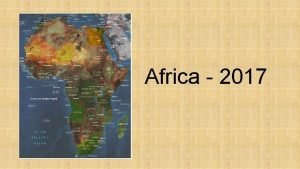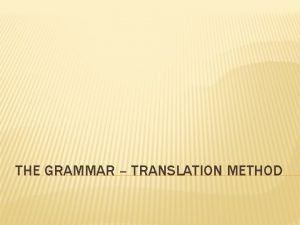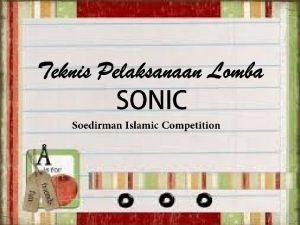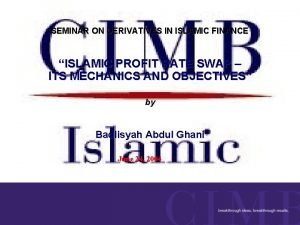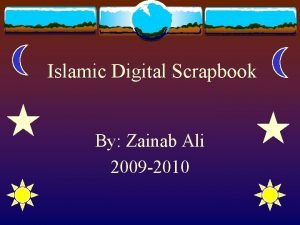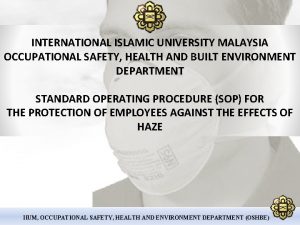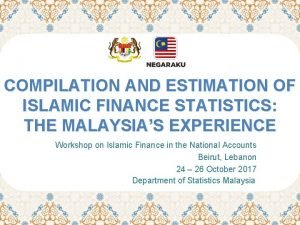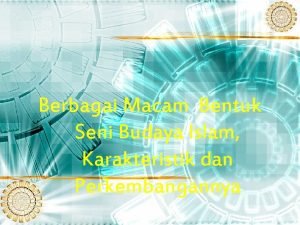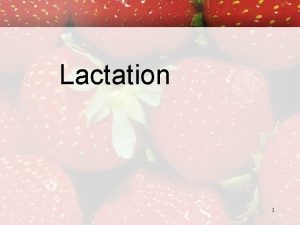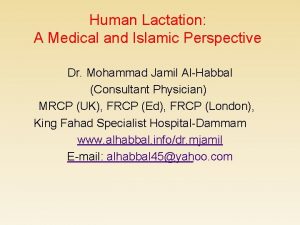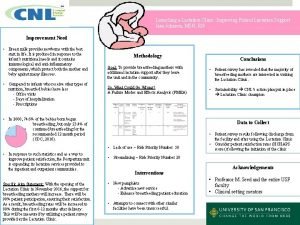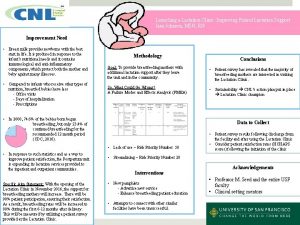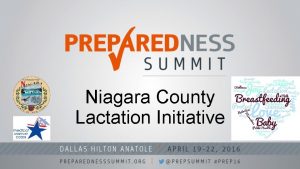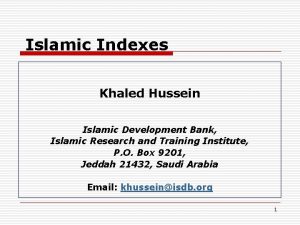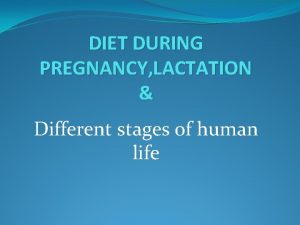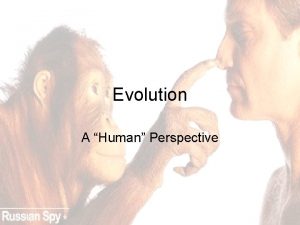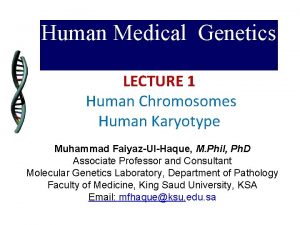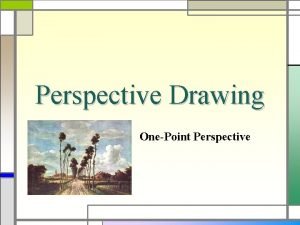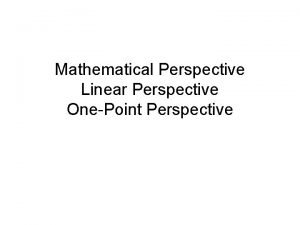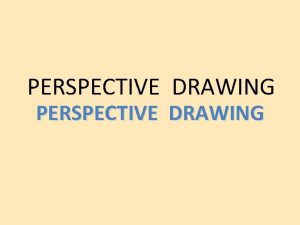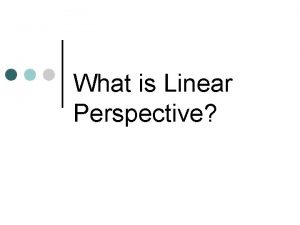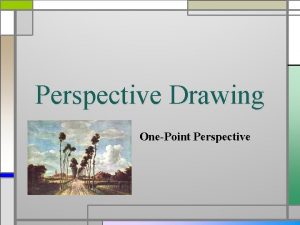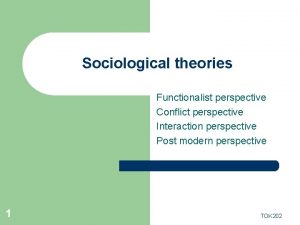Human Lactation A Medical and Islamic Perspective Dr





















































![: ﻗﺎﻝ ﺗﻌﺎﻟﻰ ﻭﻯ ﻯ ﺍ ) ( ﻳ [7 : ] ﺍﻟﻘﺼﺺ And : ﻗﺎﻝ ﺗﻌﺎﻟﻰ ﻭﻯ ﻯ ﺍ ) ( ﻳ [7 : ] ﺍﻟﻘﺼﺺ And](https://slidetodoc.com/presentation_image_h/1e10cf3c604719441b42f56520ff7764/image-54.jpg)












![: ﻗﺎﻝ ﺗﻌﺎﻟﻰ ) ﺍ ( ﻯ [6: ﺍﻟﻄﻼﻕ ] But if you make : ﻗﺎﻝ ﺗﻌﺎﻟﻰ ) ﺍ ( ﻯ [6: ﺍﻟﻄﻼﻕ ] But if you make](https://slidetodoc.com/presentation_image_h/1e10cf3c604719441b42f56520ff7764/image-67.jpg)







- Slides: 74

Human Lactation: A Medical and Islamic Perspective Dr. Mohammad Jamil Al-Habbal (Consultant Physician) MRCP (UK), FRCP (Ed), FRCP (London), King Fahad Specialist Hospital-Dammam www. alhabbal. info/dr. mjamil E-mail: alhabbal 45@yahoo. com


Human Lactation 1 - The Quran and Science 2 - Cosmic and Medical verses in the Quran 3 - Human Lactation in Islamic Teaching 4 - Medical Aspects of Human Lactation 5 - Scientific Proposal based on application of above knowledge.

The Qura’n is a book of faith (Iman) and guidance (Hidaayah). It also includes educational dimensions for the establishment of a virtuous society. Allah (SWT) says: 89 : ﺍﻟﻨﺤﻞ ﺍ ﺍﺍ ﺍﺍ " " ﻯ ﻯ ﻳ "And we have sent down to thee the book explaining all things, a guide, a mercy and glad tidings to muslims”(An Nahl: 89).

• There are many verses (Ayaat) in Al Qur’an Al Kareem which deal with different branches of science (Medical and Cosmic). • We have reviewed and classified these Ayaat according to their scientific topics. • The results were as follows:


First: There approximately (1200) Ayah which refer to the different sciences, which constitutes nearly 20% of the total number of Ayah in Al Qur’an Al Kareem (6236).

Second: • There approximately (70) Ayah praising Science and Scientists, encouraging them to be involved in discovering the universe for the good of humanity. • In fact the first five Ayah revealed to the Prophet Muhammad (PBUH ) ordered him to read and learn.


Third: The studied Ayaat were categorized according to their scientific topics as follows: Medicine 416 Geology 69 Physics 138 Seas & Rivers 35 Biology 130 Transportation 28 Astronomy & Cosmology 105 Origin of Man & others 27 Geography 98 Engineering 12 Agriculture 89 Chesmistry 11 Math. & Statistics 79 Language of birds & animals 8 All of the above & others > 20

Human Lactation(Breastfeeding) ﺃﻮﻻﺩﻫﻦ ﺣﻮﻟﻴﻦ ﻛﺎﻣﻠﻴﻦ ﻟﻤﻦ ﺍﺭﺍﺩ ﺍﻥ ﻳﺘﻢ 223 : ﺍﻟﺮﺿﺎﻋﺔ( ﺍﻟﺒﻘﺮﺓ : ﻗﺎﻝ ﺗﻌﺎﻟﻰ )ﻭﺍﻟﻮﺍﻟﺪﺍﺕ ﻳﺮﺿﻌﻦ The mothers shall give suck to their children for two whole years for those who desire to complete the period of suckling Chapter 2 – Verse 233


1 - “The first two years of a child’s life are a critical window during which the foundations for healthy growth and development are built. Infant and young child feeding is a core dimension of care in this period. ” 2 - “Breastfeeding plays an essential and sometimes underestimated role in the treatment and prevention of childhood illness. " Complementary feeding: WHO Report of the Global Consultation, Geneva, 10 -13 December 2001.

Both WHO and AAP stress the value of breastfeeding for both children and mothers. Gartner LM, et al (2005). "Breastfeeding and the use of human milk". Pediatrics 115 (2): 496 – 506.

WHO RECOMMENDATION 1. Exclusive breastfeeding for 6 months is the optimal way of feeding infants. 2. Thereafter infants should receive complementary foods with continued breastfeeding up to 2 years of age or beyond. 3. To enable mothers to establish and sustain exclusive breastfeeding for 6 months, WHO and UNICEF recommend: Initiation of breastfeeding within the first hour of life. "Exclusive Breastfeeding". WHO: Child and Adolescent Health and Development: Breastfeeding. Retrieved on 2008 -09 -22.

According to a WHO 2001 report, alternatives to breastfeeding include: 1 - Expressed breast milk from an infant’s own mother 2 - Breast milk from a healthy wet-nurse or a human-milk bank 3 - A breast-milk substitute fed with a cup, which is a safer method than a feeding bottle and teat. World Health Organization(24 -11 -2001). "Infant and Young Child Nutrition: Global strategy for infant and young child feeding”, WHO Executive Board 109 th Session provisional agenda item 3. 8 (EB 109/12).

American Academy of Pediatrics (AAP) Recommendation "Breastfeeding should be continued for at least the first year of life and beyond for as long as mutually desired by mother and child. . . Increased duration of breastfeeding confers significant health and developmental benefits for the child and the mother. . . There is no upper limit to the duration of breastfeeding and no evidence of psychologic or developmental harm from breastfeeding into the third year of life or longer. " (AAP 2005)

American Academy of Pediatrics (AAP) “ Extensive research, especially in recent years, documents diverse and compelling advantages to infants, mothers, families, and society from breastfeeding and the use of human milk for infant feeding. These include health, nutritional, immunologic, developmental, psychological, social, economic, and environmental benefits “ "Breastfeeding and the Use of Human Milk - AAP policy statement". February 2005. Retrieved on 2008 -08 -08.


Medical Aspects of Human Lactation : Breastfeeding provides multiple lifelong biologic advantages to children, including increased survival and improved neurocognitive and immune functioning. These and other advantages have been linked to breast milk components, including long chain fatty acids, epithelial growth factor, immune stimulating cells, and live maternal immune cells (lymphocytes and plasma cells), which survive gastrointestinal transport and implant in neonatal tissues.

Advantages of breastfeeding for infants 1 -Availability. 2 -Cheap. 3 - Always the right temperature and sterile. 4 - Balanced diet. 5 - Improves mother infant bonding. 6 - Improves immune status (Anti-infective). 7 - Improves neurocognitive functions and I. Q. 8 - Anti-anemic. 9 - Anti-allergic. 10 - Anti-ricketic.

Preparation of Breast for Lactation: Fertilization Pregnancy Labour Lactation. a) During pregnancy: estrogen ; progesterone ; placentae lactogen development of acini and duct system b) In puerperium: Milk secretion initiated by prolactin.

Advantages of breastfeeding for mothers 1. 2. 3. 4. 5. 6. 7. 8. Strengthen the mother-infant bonding. Natural postpartum infertility(lactation menorrhea). Decreased postpartum bleeding. Reduces the risk of breast, ovarian, uterine and endometrial cancers. Protects against osteoporosis. Reduces the risk of rheumatoid arthritis and DM. Decrease insulin requirements in diabetic women. Breastfeeding mothers tend to lose weight easier, and earlier return to pre-pregnancy weight.

Breastfeeding(Human Lactation) 1 - Nutrition 2 - Immunity 3 - C. N. S 4 - Stem Cells Growth and increased survival Improved immune functioning and prevent infection. Improved neurocognetive functions and I. Q. Tissue engrafment?

Balanced diet: Human breast milk has just the right amount of fat, sugar, water, and protein that is needed for a baby's growth and development. "Benefits of Breastfeeding". U. S. Department of Health and Human Services. Retrieved on 2007 -01 -23.

Balanced diet: 1 - Protein: 70% soluble ; easily digested. 2 - Fat: essential long chain ; DHA , ARA, needed for CNS & retina development. 3 - High lactose / galactose brain growth. 4 - High fat: in hind milk satiety. 5 - High cholesterol: myelination of nervous system. 6 - High content of vit -E, C, D, A and niacin 7 - Colostrum: increasing zinc prevent necrotizing enterocolitis.

COLOSTRUM Bright lemon yellow ; viscous fluid secreted during first 5 -7 days. Compared to mature milk it is : 1 - Very rich in immunoglobulins especially Ig. A , leucocytes ( macrophages , lymphocytes ) and antibacterial ( lactofissin , lactofirrin ) 2 - Colostrum contains approximately 5 million cells per m. L, an amount that decreases tenfold in mature milk. . 2 3 - Rich in cholesterol , Na , K , Cl , Zinc , Copper , and in Vit. A than mature milk. 4 - More rich in protein (2. 3 gm/dl) but less CHO or fat. 5 - Laxative effect by enhancing GIT motility. . 1 . 5 . 4 . 3

Colostrum Most of these leukocytes are macrophages and neutrophils, which phagocytose microbial pathogens. Lymphocytes, including T cells, natural killer cells, and antibody-producing B cells, make up 10% of the leukocytes in human breast milk. There is evidence to suggest that these cells survive passage through the infant’s gastrointestinal system where they are absorbed and influence the infant’s immune response J Am Osteopath Assoc. 2006; 106: 203– 207

Balanced diet: The foremilk and the hindmilk Two 25 ml samples of human breast milk. The left hand sample is foremilk, the watery milk coming from a full breast (High glucose) The right hand sample is hindmilk, the creamy milk coming from a nearly empty breast. (High fat)

Breastfeeding Improves IQ Extensive research on the relationship between cognitive achievement (IQ scores, grades in school) and breastfeeding has shown: 1 - Those who were breastfed had significantly higher intelligence quotient scores than comparable children breastfed for less time. The greatest gains for those children breastfed the longest. 2 - “Breast-feeding is accompanied by about a five-points higher IQ than in bottle-fed infants, " 3 - The effect of Omega-3 fatty acids -docosahexaenoic acid (DHA) and arachidonic acid (AA) - that are prevalent in breast milk but absent in infant formula. "Breastfeeding and Later Cognitive and Academic Outcomes“ Pediatrics Vol. 101 No. 1 , January 1998


Cognitive performance similar to infants nourished with breast milk

Breastfeeding, the Immune Response, and Long-term Health 1. Human breast milk provides immunologic protection against many infections mainly: diarrheal diseases, otitis media and respiratory diseases 2. Influence immune system development, affecting the pathogenesis of autoimmune disorders, including atopic allergies and the pathogenesis of chronic disease. JAOA • Vol 106 • No 4 • April 2006 • 203 -207

Immunologic Factors in Human Breast Milk 1. Secretory Ig A (s. Ig. A). 2. Leukocytes: Mostly are macrophages and neutrophils, which phagocytose microbial pathogens. Lymphocytes, including T cells, natural killer cells, and antibodyproducing B cells, make up 10% of the leukocytes in human breast milk. These cells survive passage through the infant's gastrointestinal system where they are absorbed and influence the infant's immune response. 3. Lysozyme: inhibits the growth of many bacteria. 4. Lactoferrin : limits bacterial growth by removing essential iron 5. Nucleotides : enhance immune function in infants. 6. Complex sugars: prevent adherence of various microbial pathogens


Breastfeeding and HIV/AIDS When a mother has HIV, the dangers of not breastfeeding must be balanced against the risk of HIV transmission 1. Advice for HIV-positive mothers in developed countries They should avoid breastfeeding altogether because the risk of HIV transmission far outweighs the risks associated with replacement feeding. Nevertheless the UK Department of Health advises that “Under exceptional circumstances, and after seeking expert professional advice on reducing the risk of transmission of HIV through breastfeeding, a highly informed and motivated mother might be assisted to breastfeed. ” Department of Health, "HIV and Infant Feeding: Guidance from the UK Chief Medical Offices' Expert Advisory Group on AIDS“ , September 2004.

Breastfeeding and HIV/AIDS 2. Advice for HIV-positive mothers in developing countries In countries with fewer resources, where replacement feeding can be much more hazardous: exclusive breastfeeding is recommended. “When replacement feeding is acceptable, feasible, affordable, sustainable and safe, avoidance of all breastfeeding by HIV-infected mothers is recommended. Otherwise, exclusive breastfeeding is recommended during the first months of life. ” WHO, "New data on the prevention of Mother-to-Child Transmission of HIV and their policy implications, 2001

Breastfeeding and HIV/AIDS 3. conclusion: A study of nearly three thousand mothers in South Africa confirmed that mixed feeding carries a higher risk of HIV infection than exclusive breastfeeding. The team who conducted the research suggested that WHO infant feeding guidelines should be revised in favour of exclusive breastfeeding. Coovadia et al, "Mother-to-child transmission of HIV-1 infection during exclusive breastfeeding in the first 6 months of life: an intervention cohort study", The Lancet 369(9567), 31 March 2007

Breastfeeding, the Immune Response, and Long-term Health 1. Human breast milk provides immunologic protection against many infections mainly: diarrheal diseases, otitis media and respiratory diseases 2. Influence immune system development, affecting the pathogenesis of autoimmune disorders, including atopic allergies and the pathogenesis of chronic disease. JAOA • Vol 106 • No 4 • April 2006 • 203 -207

Allergy, Autoimmunity, and Breastfeeding decrease individuals' future susceptibility to autoimmune disorders, namely: 1. Allergic rhinitis and atopic allergies. 2. Crohn's disease and ulcerative colitis. 3. IDDM or diabetes-related auto-antibodies. -----------------------------------------1 - Van Odijk J, et al. Breastfeeding and allergic disease: a multidisciplinary review of the literature (1966– 2001). Allergy. 2003; 58: 833 – 843. 2 - Corrao G, et al. Risk of inflammatory bowel disease attributable to smoking, oral contraception and breastfeeding in Italy. Int J Epidemiol. 1998; 27: 397– 404 3 - Sadauskaite-Kuehne V, et. al( Longer breastfeeding is an independent protective factor against development of type 1 diabetes mellitus in childhood. ) Diabetes Metab Res Rev. 2004; 20: 150 – 157

Breastfeeding can be helpful for preventing allergy by: 1. reducing exposure to potential allergens. 2. speeding maturation of the protective intestinal barrier in baby's gut. 3. coating the gut and providing a barrier to potentially allergenic molecules. 4. providing anti-inflammatory properties that reduce the risk of infections (which can act as allergy triggers).

Breast milk vs. Formula Breast milk Formula Convenience Always available, premixed and warmed. May require some preparation. Hygiene Sterile Requires clean containers and water. Immunology Maternal Ig. A N/A Bonding Maternal-Infant bonding. Also Can bond with any may pump. appropriate care giver. Vitamins/ Minerals Bioavailable iron. Insufficient Vitamin D. Iron usually added. Vitamin D added. Fat Omega-3 fatty acids N/A Protein Lactoferrin (E. coli protective iron-binding protein) Cow’s milk protein allergies/eczema

Human milk contains stem cells : 1. Inclusion of stem cells in the cellular components of breast milk, with the possibility of passage to the newborn. 2. Establishment of lactation-derived stem cells in infant tissues, with future possible life long effects.

J Hum Lact. 2006 Aug; 22(3): 270 -1. Breast milk: an unappreciated source of stem cells. • Mc. Gregor JA, • Rogo LJ. Columbia University School of Medicine. PMID: 16885486 [Pub. Med - indexed for MEDLINE]

Breast milk contains stem cells Mammary stem cells (red/blue) and differentiated adult mammary cells (green) isolated from human breast milk

Identification of nestin-positive putative mammary stem cells in human breastmilk � � Mark D. Cregan , et. al Journal Cell and Tissue Research Volume 329, Number 1 / July, 2007

� Abstract Stem cells in mammary tissue have been well characterised by using the mammary stem cell marker, cytokeratin (CK) 5 and the mature epithelial markers CK 14, CK 18 and CK 19. As these markers have never been reported in cells from breastmilk, the aim of this study has been to determine whether mammary stem cells are present in expressed human breastmilk. Cultured cells from human breastmilk were studied by using immunofluorescent labelling and reverse transcription/polymerase chain reaction (RT-PCR). We found a heterogeneous population of cells with differential expression of CK 5, CK 14, CK 18 and CK 19. Further, by using the multipotent stem cell marker, nestin, we identified cells in culture that were positive only for nestin or double-positive for CK 5/nestin, whereas no co-staining was observed for CK 14, CK 18 and CK 19 with nestin. When cells isolated from breastmilk were analysed by using RT-PCR prior to culture, only nestin and CK 18 were detected, thereby indicating that breastmilk contained differentiated epithelial and putative stem cells. Furthermore, fluorescence-activated cell-sorting analysis demonstrated, in breastmilk, a small side-population of cells that excluded Hoechst 33342 (a key property of multipotent stem cells). When stained for nestin, the cells in the side-population were positive, whereas those not in the sidepopulation were negative. The presence of nestin-positive putative mammary stem cells suggests that human breastmilk is a readily available and non-invasive source of putative mammary stem cells that may be useful for research into both mammary gland biology and more general stem cell biology.

Dr. Cregan believes that the mother's breast milk: 1. Provides for the newborn in the same way that the placenta provided for the preborn baby. 2. Helps ensure that a baby fulfills his genetic destiny. 3. Human milk stem cells have all the physical characteristics of fetal stem cells , with the potential to differentiate into multiple cell types. This means the cells could potentially be “reprogrammed” to form many types of human tissue. 4. It highlights again the incredible gap between artificial infant formula and human milk. (formula can never provide the developmental guidance. )

Dr. Mark Cregan concluded: Human breast milk is a novel source of nestin + putative mammary stem cells which can be obtained non-invasively from lactating women. Thus creating a plentiful and ethical source of stem cells for use in a wide range of applications with regard to mammary gland stem cell biology. 1. 2. Identification of nestin-positive putative mammary stem cells in human breast milk Cell tissue Res (2007) 329: 129 -136

Human Lactation in Islamic Teaching 1 - From the Holy Quran 2 - From the traditions of the Prophet Muhammad (PBUH) 3 - From the eminent Companions of the Prophet (PBUH) such as Ali ibn Abee Taleb(RA)


The word “Breastfeeding” and its synonyms are repeated in the Quran 14 times distributed in 7 Surah (chapters) and 8 Ayaah (verses) as follows: No. Name of Surah No. of Ayaah The word 1. Al-Baqarrah ( The Cow) 233 ﺗﺴﺘﺮﺿﻌﻮﺍ ، ﻓﺼﺎﻻ ، ﺍﻟﺮﺿﺎﻋﺔ ، ﻳﺮﺿﻌﻦ 2. An-Nisa` ( The Women) 23 ﺍﻟﺮﺿﺎﻋﺔ ، ﺃﺮﺿﻌﻨﻜﻢ 3. Al-Hajj (The Pilgramage) 2 ﺃﺮﺿﻌﺖ ، ﻣﺮﺿﻌﺔ 4. Al-Qasas (The Stories) 7 12 ﺍﺭﺿﻌﻴﻪ ﺍﻟﻤﺮﺍﺿﻊ 5. Luqman 14 ﻭﻓﺼﺎﻟﻪ 6. Al-Ahqaaf 15 ﻭﻓﺼﺎﻟﻪ 7. Al- Talaaq (The Divorce) 6 ﻓﺴﺘﺮﺿﻊ ، ﺍﺭﺿﻌﻦ

ﺍﺍ : ﻗﺎﻝ ﺗﻌﺎﻟﻰ ) ﺍ ﺍ ﻯ ﺍ ﺍ ﺍ ﻱ ﺍ [14 : ﺍﻳ( ]ﻟﻘﻤﺎﻥ And we enjoined mankind regarding his parents – his mother carried him in weakness upon weakness and his weaning/disengagement
![ﻗﺎﻝ ﺗﻌﺎﻟﻰ ﻭﻯ ﻯ ﺍ ﻳ 7 ﺍﻟﻘﺼﺺ And : ﻗﺎﻝ ﺗﻌﺎﻟﻰ ﻭﻯ ﻯ ﺍ ) ( ﻳ [7 : ] ﺍﻟﻘﺼﺺ And](https://slidetodoc.com/presentation_image_h/1e10cf3c604719441b42f56520ff7764/image-54.jpg)
: ﻗﺎﻝ ﺗﻌﺎﻟﻰ ﻭﻯ ﻯ ﺍ ) ( ﻳ [7 : ] ﺍﻟﻘﺼﺺ And we communicated to the mother of Musa that you give suck to him Chapter 28 – Verse 7

: ﻗﺎﻝ ﺗﻌﺎﻟﻰ . . . ) ﺍ ﻭﺍ ﺍ ﺍ آ ﺍﻟ ﺍ ﺍﻭ ﺍ ﻭﺍ ﺍﻟ ﺍﻭﺍ ( ﻳ ﻭ [233 : ] ﺍﻟﺒﻘﺮﺓ . . . And if you decide on a foster suckling-mother for your children, there is no sin on you, provided you pay (the lactating mother) what you agreed (to give her) on a reasonable basis. . . Chapter 2, Verse 233

: ﻗﺎﻝ ﺗﻌﺎﻟﻰ ( ) ﺍ ﺍ ﻭﺧﺎﻻﺗﻜﻢ ﻭﺑﻨﺎﺕ ﺍﻷﺦ ﻭﺑﻨﺎﺕ ﺍﻷﺨﺖ ﻭﺃﻤﻬﺎﺗﻜﻢ ﺍﻟﻼﺗﻲ ﺃﺮﺿﻌﻨﻜﻢ ﺍ ﺍﻟ ﺍﺓ [23 : ]ﺍﻟﻨﺴﺎﺀ Prohibited to you for marriage are your mothers, and your daughters, and your sisters, and your father’s sisters, and your mother’s sisters, and brother’s daughters, and sister’s daughters, and your foster mothers who breastfed you, and your sisters by virtue of breastfeeding. . . Chapter 4 – Verse 23





We conclude from these Islamic teachings on human lactation: 1. Mother’s breastfeeding is highly encouraged. 2. Up to two years of nursing is advisable. 3. Lactation from a “wet-nurse” is the alternative choice next to mother breastfeeding. 4. Human milk is the best nutrition for infants and not the cows’ milk or its formulae. 5. Five breastfeeding meals or more(during the 2 years of lactation period) will induce consanguinity and the shared breastfed infants(non related) will be brothers and sisters in lactation.

CONCLUSION & HYPOTHESIS! 1. Human lactation is the best source of nutrition for proper growth and development for children, as well as prevention of diseases (preventive breastfeeding) 2. Human milk can induce biological changes in the breastfed non related infant, which can be used as a method for treatment of certain diseases (Therapeutic breastfeeding)

Breastfeeding provides for the infant in the same way that the placenta provided for the preborn baby. Dr. Mark D. Cregan

THE PROPOSAL Human lactation leads to brotherhood effects between the infant and the unrelated infants fed by the same breast (wet nurse). A fact which was first stated by the Islamic principles (Quran & Hadith). This brotherhood is presumably based on many biological changes generated by breast feeding, specially the presence of stem cells in the human milk. This study aims at investigating these changes which make non related infants, brothers and sisters induced by shared lactation. Our approach will be either genetic or immunological or both. Investigating this issue may improve our methods for prevention and treatment of certain diseases (especially hereditary diseases).

Applications of the proposal : 1. Organ transplantation : Brotherhood in lactation as a donor for organ transplantation. Better than non-related donor. 2. Therapeutic breastfeeding : Treatment of certain diseases for e. g single gene defects (carrier or affected ) diagnosed antenataly or after labour. Feeding those affected infants with human milk from healthy non-related lactating mothers.

Antenatal diagnosis of single gene defect diseases e. g Hb. S & B-thalassaemia major (Antenatal diagnosis should be offered if a pregnant woman found to have Hb defect, specially if both are affected as there is a risk of severe fetal Hb defect. Fetal DNA analysis can be carried out using amniotic fluid, chorionic villus biopsy or fetal blood sample. Abortion is offered if the fetus is found to be affected ). Kumar & Clark, Clinical Medicine, 6 th ed. 2007, P 445.
![ﻗﺎﻝ ﺗﻌﺎﻟﻰ ﺍ ﻯ 6 ﺍﻟﻄﻼﻕ But if you make : ﻗﺎﻝ ﺗﻌﺎﻟﻰ ) ﺍ ( ﻯ [6: ﺍﻟﻄﻼﻕ ] But if you make](https://slidetodoc.com/presentation_image_h/1e10cf3c604719441b42f56520ff7764/image-67.jpg)
: ﻗﺎﻝ ﺗﻌﺎﻟﻰ ) ﺍ ( ﻯ [6: ﺍﻟﻄﻼﻕ ] But if you make difficulties for one another then some other woman may give suck for him. Chapter 65 – Verse 6



The advantages of human milk as a source of stem cell replacement therapy 1 - Natural 2 - Available 3 - Cheap-economical 4 - Ethical 5 - Non-invasive. 6 - No immunosuppression 7 - No side effects 8 - Effective? ? But needs a lot of researches !!


Thank you!


THE TRUTH (AYAAT) MANKIND The Holy QURAN SCIENTIFIC KNOWLEDGE UNIVERSE
 Lactation drugs
Lactation drugs Lactation physiology
Lactation physiology United states lactation consultant association
United states lactation consultant association Lactation
Lactation Milk let down
Milk let down Lactation
Lactation Lactation mastitis treatment
Lactation mastitis treatment Leydig cells histology
Leydig cells histology Levocetirizine lactation
Levocetirizine lactation Teat meatus
Teat meatus Lactation tetany
Lactation tetany Motivation in islamic perspective
Motivation in islamic perspective Kulliyyah of islamic revealed knowledge
Kulliyyah of islamic revealed knowledge Islamic medical center kuwait
Islamic medical center kuwait 1 point perspective vs 2 point perspective
1 point perspective vs 2 point perspective Silo perspective vs business process perspective
Silo perspective vs business process perspective Hepburn osteometric board
Hepburn osteometric board An investment perspective of human resource management
An investment perspective of human resource management Investment perspective of human resource management
Investment perspective of human resource management Doctors license number
Doctors license number Gbmc infoweb
Gbmc infoweb Torrance memorial medical center medical records
Torrance memorial medical center medical records Cartersville medical center medical records
Cartersville medical center medical records Basic concept of islamic law and jurisprudence
Basic concept of islamic law and jurisprudence Sarcophagus of junius bassus
Sarcophagus of junius bassus Characteristics of early christian art
Characteristics of early christian art Islamic banking benefits and disadvantages
Islamic banking benefits and disadvantages Islamic gunpowder empires ottomans safavids and mughals
Islamic gunpowder empires ottomans safavids and mughals Human needs and human development
Human needs and human development Chapter 8 human needs and human development
Chapter 8 human needs and human development Non human nouns
Non human nouns Human resources administration medical assistance program
Human resources administration medical assistance program What is islamic art
What is islamic art Largest islamic empire
Largest islamic empire Example of principles of islamic management
Example of principles of islamic management Islamic interbank money market
Islamic interbank money market خطبة حجة الوداع
خطبة حجة الوداع Backbiting in islam
Backbiting in islam Mahmood ul hassan islamic aid
Mahmood ul hassan islamic aid Islamic accepted bills
Islamic accepted bills Islamic topic in english
Islamic topic in english Islamic microfinance in uganda
Islamic microfinance in uganda Islamic powerpoint slide design free download
Islamic powerpoint slide design free download Doris duke foundation for islamic art
Doris duke foundation for islamic art Islamic prophets family tree
Islamic prophets family tree Islamic jeopardy questions
Islamic jeopardy questions Ottoman empire founder
Ottoman empire founder How big was the islamic empire
How big was the islamic empire Chapter 19 islamic gunpowder empires
Chapter 19 islamic gunpowder empires An approach to english translation of islamic texts
An approach to english translation of islamic texts Islamic constitution
Islamic constitution Nature of islamic economics
Nature of islamic economics Islamic gunpowder empires webquest
Islamic gunpowder empires webquest Jeopardy islam
Jeopardy islam Islamic business management
Islamic business management Principles of islamic art
Principles of islamic art Iqra islamic foundation
Iqra islamic foundation Principle of islamic management
Principle of islamic management Islamic lessons for youth
Islamic lessons for youth Islamic studies lesson plan samples
Islamic studies lesson plan samples Muqith wordpress grade 4
Muqith wordpress grade 4 Pillars of murabahah
Pillars of murabahah Islamic empire map activity answer key
Islamic empire map activity answer key Chapter 9 lesson 3 islamic civilization
Chapter 9 lesson 3 islamic civilization Chapter 27 the islamic empires
Chapter 27 the islamic empires Chapter 27 the islamic empires
Chapter 27 the islamic empires The bantu capital city in zimbabwe was called _____.
The bantu capital city in zimbabwe was called _____. The grammar translation method advantages and disadvantages
The grammar translation method advantages and disadvantages Sonic islamic
Sonic islamic Islamic structuring
Islamic structuring Islamic profit rate swap
Islamic profit rate swap Islamic scrapbook
Islamic scrapbook Islamic online university malaysia
Islamic online university malaysia Islamic banking statistics
Islamic banking statistics Macam macam seni budaya islam
Macam macam seni budaya islam
